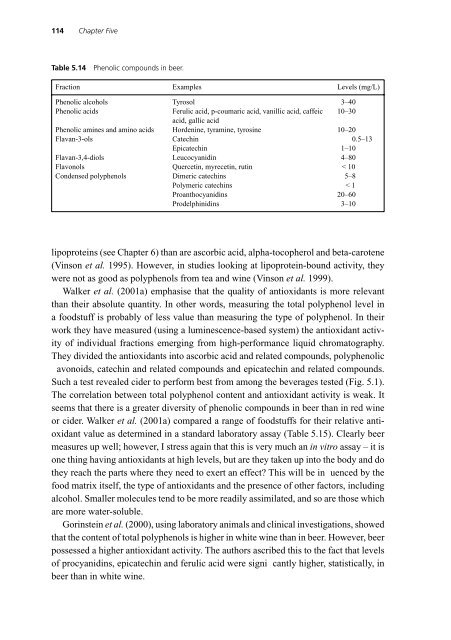Beer : Health and Nutrition
Beer : Health and Nutrition
Beer : Health and Nutrition
Create successful ePaper yourself
Turn your PDF publications into a flip-book with our unique Google optimized e-Paper software.
114 Chapter Five<br />
Table 5.14 Phenolic compounds in beer.<br />
Fraction Examples Levels (mg/L)<br />
Phenolic alcohols Tyrosol 3–40<br />
Phenolic acids Ferulic acid, p-coumaric acid, vanillic acid, caffeic<br />
acid, gallic acid<br />
10–30<br />
Phenolic amines <strong>and</strong> amino acids Hordenine, tyramine, tyrosine 10–20<br />
Flavan-3-ols Catechin 0.5–13<br />
Epicatechin 1–10<br />
Flavan-3,4-diols Leucocyanidin 4–80<br />
Flavonols Quercetin, myrecetin, rutin < 10<br />
Condensed polyphenols Dimeric catechins 5–8<br />
Polymeric catechins < 1<br />
Proanthocyanidins 20–60<br />
Prodelphinidins 3–10<br />
lipoproteins (see Chapter 6) than are ascorbic acid, alpha-tocopherol <strong>and</strong> beta-carotene<br />
(Vinson et al. 1995). However, in studies looking at lipoprotein-bound activity, they<br />
were not as good as polyphenols from tea <strong>and</strong> wine (Vinson et al. 1999).<br />
Walker et al. (2001a) emphasise that the quality of antioxidants is more relevant<br />
than their absolute quantity. In other words, measuring the total polyphenol level in<br />
a foodstuff is probably of less value than measuring the type of polyphenol. In their<br />
work they have measured (using a luminescence-based system) the antioxidant activity<br />
of individual fractions emerging from high-performance liquid chromatography.<br />
They divided the antioxidants into ascorbic acid <strong>and</strong> related compounds, polyphenolic<br />
avonoids, catechin <strong>and</strong> related compounds <strong>and</strong> epicatechin <strong>and</strong> related compounds.<br />
Such a test revealed cider to perform best from among the beverages tested (Fig. 5.1).<br />
The correlation between total polyphenol content <strong>and</strong> antioxidant activity is weak. It<br />
seems that there is a greater diversity of phenolic compounds in beer than in red wine<br />
or cider. Walker et al. (2001a) compared a range of foodstuffs for their relative antioxidant<br />
value as determined in a st<strong>and</strong>ard laboratory assay (Table 5.15). Clearly beer<br />
measures up well; however, I stress again that this is very much an in vitro assay – it is<br />
one thing having antioxidants at high levels, but are they taken up into the body <strong>and</strong> do<br />
they reach the parts where they need to exert an effect? This will be in uenced by the<br />
food matrix itself, the type of antioxidants <strong>and</strong> the presence of other factors, including<br />
alcohol. Smaller molecules tend to be more readily assimilated, <strong>and</strong> so are those which<br />
are more water-soluble.<br />
Gorinstein et al. (2000), using laboratory animals <strong>and</strong> clinical investigations, showed<br />
that the content of total polyphenols is higher in white wine than in beer. However, beer<br />
possessed a higher antioxidant activity. The authors ascribed this to the fact that levels<br />
of procyanidins, epicatechin <strong>and</strong> ferulic acid were signi cantly higher, statistically, in<br />
beer than in white wine.

















